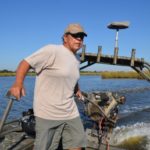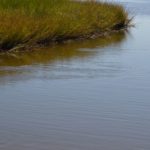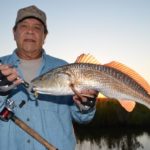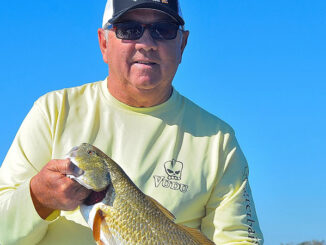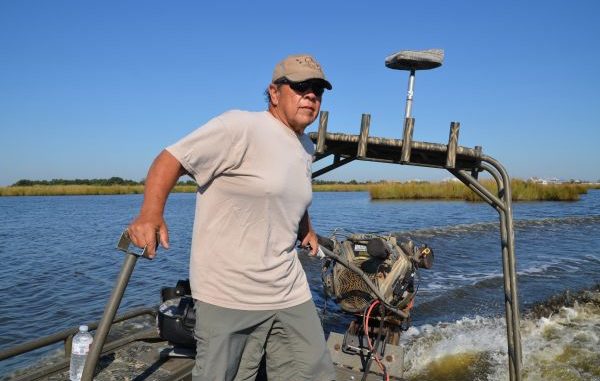
Cold fronts and blustery winds can make fishing a challenge this month, but redfish are prowling the shallows looking for baitfish. Here’s how this Myrtle Grove guide uses a surface-drive boat to catch them.
I shivered involuntarily in the predawn light. It felt more like I was going duck hunting than fishing, especially since I was in a surface drive-driven shallow-water boat.
“There’s something about being on the water this time of morning that does it for me,” Junior Mendoza growled. “I like coming out early, but redfish really become more active when the light is on the water.
“If I catch a redfish before the sun is up, it’s lagniappe — not like trout.”
In the background, the lights of Myrtle Grove twinkled in the breaking dawn.
“I like fishing not just where others can go, but where the redfish are,” Mendoza said by way of explaining why he uses a surface-drive boat. “You can get into shallow water with a surface drive. Redfish love shallow water — that’s all there is to it.”
But it’s not just the redfish that love these areas. Mendoza would much rather be in the shallows than probing deeper water.
“Shallow marsh waters are … protected from the wind,” he said. “March is a tough month. It’s a windy month.
“A lot of my fishing is sight-fishing. With a lot of wind, it’s hard to see nervous water, something different than what you ordinarily see.”
He flashed a big smile, visible in the early light.
“But even if it’s tough, if you like to fish it’s a lot better than not fishing at all,” Mendoza said.
Mendoza’s boat is wide: 60 inches across the bottom, which is perfect for this style of fishing.
“The average boat this length is 48 inches,” he said. “A wider boat draws less water and it’s also less tipsy.”
His Mud Buddy mud motor is a 35-horsepower model that the mechanics at The Boat Doctor Inc. have souped up to 55 horses.
“The extra horsepower is helpful if the boat’s hull sticks in the shallows,” Mendoza explained. “With an outboard motor, you have to trim the lower unit up when you get stuck, and you lose power. With a surface-drive motor, you trim it down so that it digs in the mud.
“You sweep the motor back and forth to get the hull up on step — that’s where the extra horsepower comes in handy.”
As he ran to where he wanted to start fishing, he had enough light to see alarmed redfish scooting out from the shallows. He became visibly agitated at seeing so many fish, although he has probably seen them a thousand times before.
Even Ginger, his regular fishing partner — a 3-year-old yellow British Labrador retriever — seemed excited.
With his trolling motor, Mendoza stealthily approached the shoreline he wanted to fish, shutting down the big motor well out. He lowered his voice several notches, too, almost whispering as he explained what else he looks for besides nervous water.
“I really like to see redfish pushing in shallow water,” he said. “A redfish working for food will make a V wake with its dorsal fin as it moves; they are different than the V wakes made by redfish spooked by boats.
“There is only a 10-percent chance of catching a spooked redfish. A badly spooked one will make a blow-out — a puff of mud.”
Medoza began to slowly troll parallel to the shore in what he called the “ditch,” the 2-foot deep channel of the slough in which he was fishing. He was tossing an H & H Redfish Spinner into 3 inches of water along the shore.
“Another thing to look for, although it is less common, is tailing — the tip of a tail sticking out of the water when the redfish is nosing in the mud for food,” he said. “Also good is bait movement — small fish or shrimp on the surface — with bigger movement caused by a fish nearby.”
Mendoza’s eye caught a redfish working the shallows, and he placed his lure where the fish would have to intercept it. It did, and he quickly wrested it into the boat.
The sun was just crawling over the horizon; he had his lagniappe fish.
He continued to work the bank, chunking his lure into an inch or 2 of water.
“You got to remember that redfish actually swim in the mud,” he quietly lectured. “I will catch 20-inch redfish in 1 inch of water. But you got to remember that there is a foot of soft mud.”
When he iced his first fish, he carefully took the bag of ice out of the ice chest, laid the fish in the chest and then set the whole bag on top of the fish to keep it from banging around in the box.
Mendoza’s motto for shallow water fishing is “Silence is Golden.”
As the day progressed and the wind picked up, he positioned the boat in each spot he wanted to fish so that he worked downwind. Working upwind would have created wave-slap noise on the side of the boat’s hull.
“Don’t drop things in the boat,” he murmured. “Turn off the radio — no music, no football games.
“Don’t yell.”
He turned around and looked at me for emphasis.
After the first fish, things got tough. Plenty of redfish were moving, but it seemed like they had lockjaw.
Mendoza moved the boat often, looking to make things click. He noticeably gravitated toward lee shores. It was windy, and he could see fish sign better in the slick waters of the lee.
He liked spots with a lot of aquatic plants, too.
“One of the good things about fishing the shallows in March is that you have a lot of grass to break wave action,” he noted.
The area Mendoza was fishing was a wire grass brackish marsh. Some of the lagoon, pond and bayou shorelines were relatively intact.
But portions of the marsh were what Louisiana fishermen call “broken marsh,” fragmented islands of plants interlaced with open water.
In short, it was perfect redfish habitat.
The fish just wouldn’t cooperate. But the unflappable Mendoza just kept plugging away, talking to his dog like she was his chief counselor.
Seven o’clock came and went, followed quickly by 8 a.m. and then 9:00. He changed baits, but nothing seemed to work.
Soon 10 o’clock loomed, and Mendoza had only one fish in the boat — the lagniappe fish he caught at dawn.
He announced that he was moving to a spot that seemed, from previous trips, to be a travelling lane for redfish on the type of tide that existed at this point in the day.
At 10 o’clock sharp, a huge wake closed in on his spinner and made the water explode with its violent hit. It joined the first fish in the box.
Two casts later, an even bigger one tried him out. After wrestling it in, he deemed it too large and released it.
The next one, just a few casts later, he turned loose because it was too small.
Like Goldilocks, he wanted the ones that were just right.
He fished up the bank, but got nary another hit, even though it was indistinguishable from where he caught the fish.
“Hmmm,” he muttered to himself, turning the boat around.
When he reached the hotspot, he nailed another keeper, quickly followed by another one. You could see every fish coming in the shallows well before they hit the bait.
“You can’t set the hook when you see them take the bait,” he counseled, “especially with braided line. You have to feel them first. Otherwise you will pull the hooks out of their mouths.”
The boat moved out of the small hotspot and he stopped catching.
So he turned around and moved back into the kill zone. Almost immediately another fish slammed the spinner.
With his limit in the box, Mendoza stepped down from the bow deck to put his rod up.
“Redfish are a good-pulling fish, easy to catch and more plentiful than bass,” he said. “But did I tell you I like eating them on the half-shell?”
He patted the lid of the ice chest.
